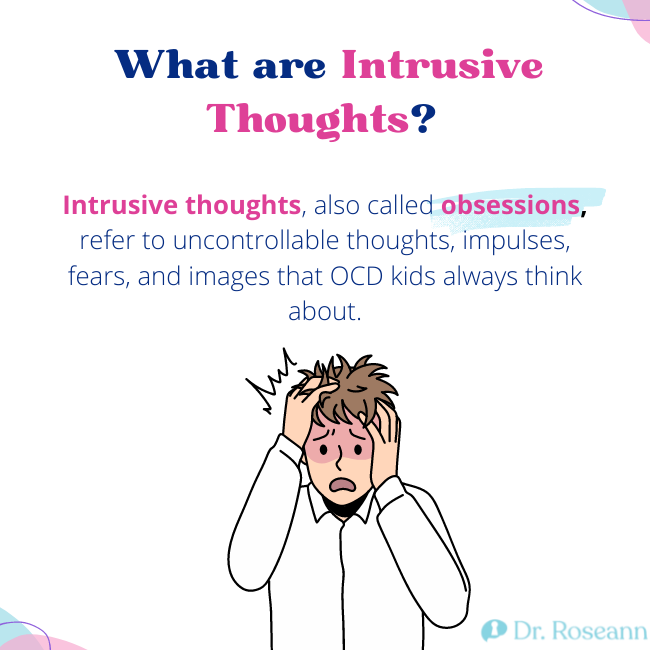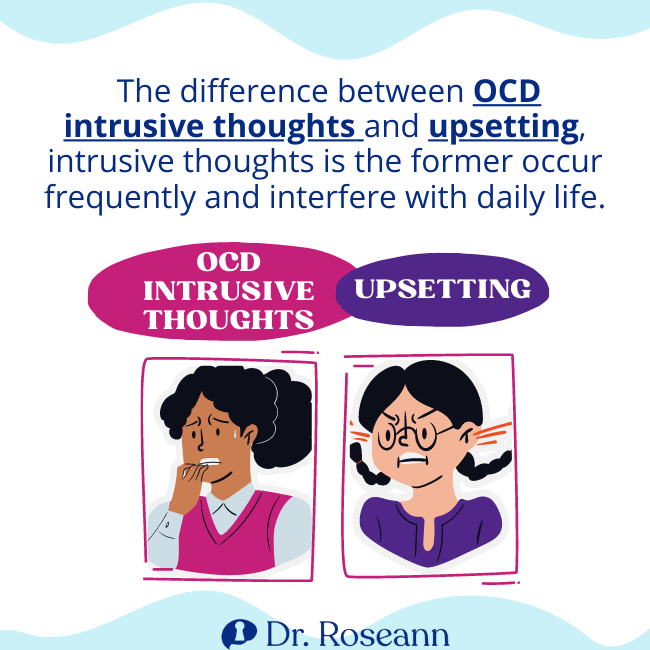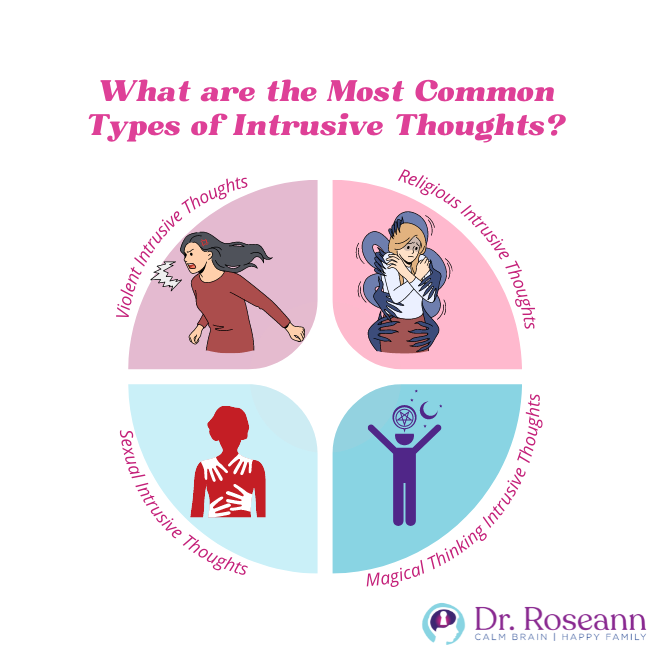OCD, or Obsessive-Compulsive Disorder, is regarded as one of the most treatment-resistant mental health disorders because of the strong behavioral habitation that forms. There are also few specialized providers who can properly diagnose and treat this clinical condition. So it's no wonder parents may have difficulty finding a solution that works for their children and teens.
If a child suffers from OCD, their brain gets stuck in a loop. As a result, their behaviors and thoughts are repeated several times over and go outside their control. These behaviors are driven mainly by the need to prevent a bad thing from happening, which gets reinforced every time they repeat the behavior.
What are Intrusive Thoughts?

Intrusive thoughts, also called obsessions, refer to uncontrollable thoughts, impulses, fears, and images that OCD kids always think about. A typical example of intrusive thought is the fear that they or someone they care about will get hurt, become sick, or die.
Intrusive thoughts don't make sense, but kids with OCD can't stop thinking about them. These OCD thoughts make a person feel uncomfortable, anxious, fearful, disgusted, or doubtful.
OCD is hard on kids and families. Abby's OCD about her mother dying made her feel so ashamed that her shame got in the way of her getting better as much as the OCD itself. A lot of psychoeducation about OCD and the brain really helped Abby to break out of the shame cycle and move forward in her Exposure Response Prevention therapy.
While some may seem to experience common obsessions, these intrusive thoughts make it hard for children to concentrate, get involved with any social interaction, or do their daily chores. For some children and teens with OCD, these intrusive thoughts can completely debilitate them.
Parents may think of intrusive thoughts as random thoughts that have no connection to anything that their children are doing. However, these obsessive thoughts may come out of nowhere and can be about anything. They aren't typically rooted in anything real.

However, everyone can get these unwanted thoughts, which doesn't necessarily mean they have OCD. OCD intrusive thoughts are those that follow you around and cause feelings of distress. These are negative thoughts about topics you find disturbing and disgusting, and it feels unsettling just thinking about them. The difference between OCD intrusive thoughts and upsetting, intrusive thoughts is the former occur frequently and interfere with daily life. People who get unwanted intrusive thoughts every once in a while would typically ignore them.
What are the Most Common Types of Intrusive Thoughts?

For those with OCD, these distressing thoughts are challenging to control. The thoughts cause extreme emotional distress and keep them from living normally. There are many types of intrusive thoughts that children and teens experience but these are the most common.
#1 Violent Intrusive Thoughts
Violent intrusive thoughts may include mental images and impulses to act upon violent or extremely harmful thoughts. OCD children and teens with violent intrusive thoughts may see themselves hurting themselves or others. They harbor ideas of hitting, injuring, strangling, stabbing, or mutilating a child, family member, friend, pet, stranger, or themselves.
In their mind, they envision themselves with knives and guns doing violent acts. But, on the other hand, if they think about hurting themselves, they feel the urge to throw themselves into the path of a car or train or jump out of a window or balcony.
OCD teens driving a car may think of different ways of hurting people, such as hitting pedestrians, ramming their vehicle into the crowd, or moving straight into oncoming traffic. They may even think about opening the exit doors of a flying airplane.
As a result of these violent thoughts, children and kids with OCD do compulsive acts to relieve themselves of their anxiety whenever these ideas come to their heads. They assume that these mental compulsions alleviate their fears and anxieties.
These types of thoughts can be very frightening for the child and family and can often trigger inpatient psychiatric hospitalization. The fear can build and cause an extreme amount of distress.
However, all they get is temporary relief. A lot of time, these compulsions become problems themselves. They will start doing these compulsions for just several minutes a day to several hours multiple times a day until they can no longer function.
#2 Religious Intrusive Thoughts
Religious intrusive thoughts may include blasphemous thoughts, hyper-morality, compulsive prayers, and unjustified concerns about committing sins. These thoughts are also called scrupulosity.
The anxiety experienced by those with intrusive religious thoughts is connected to committing a sin and the guilt that comes with it. As a result, their religious rituals and practices become their compulsive behaviors. One study shows that individuals with spiritually intrusive thoughts tend to suffer from a more severe OCD and exhibit higher levels of disability (McIngvale et al., 2017).
Having those intrusive religious thoughts does not necessarily mean one appreciates religion or is very devout. On the contrary, people having these thoughts may feel less fulfilled or spiritual by praying repeatedly or constantly seeking reassurance.
They even say that their thoughts interfere with their religious duties. One study shows that those suffering from scrupulosity or religious OCD are less likely to seek and receive medical treatments (Siev et al., 2011). Because religion is a positive for most, the signs may be missed until the behaviors are deeply entrenched.
#3 Sexual Intrusive Thoughts
Kids and teens may have sexually intrusive thoughts as well, which is hard for them because most of them are ashamed of having these thoughts. Sexual thoughts may come in several forms, and the type that's very common among younger people is the one that relates to sexual orientation or what's called homosexual OCD.
For example, a teen may be obsessed with being gay, though they haven't been attracted to anybody of the same sex. On the other hand, it's that worry that whatever they're doing during social interactions can be interpreted as a sexual advance. For these teens, accidentally touching another person's hand is scary.
Sexual intrusive thoughts can be embarrassing for both the child and the parent. It also can create worry that a child may have been sexually abused, which should always be explored as part of the OCD intake process. However, intrusive thoughts and compulsions should be treated with ERP therapy.
#4 Magical Thinking Intrusive Thoughts
Frequently, these magical thinking intrusive thoughts are linked to the superstitions a child or teen may believe in to prevent harm or negative experiences to themselves or others. These kids think they are responsible for something awful that happened because they fail to do a specific set of actions.
These thoughts usually start small and then become more prominent over time. For people with OCD, it directly interferes with their daily life as these mental rituals can become time-consuming and may cause them to avoid specific locations, situations, and people.
While it's hard to think that kids may already have superstitions, an excellent example is an urge to brush their teeth three times before going to school. If they don't do it, they will be humiliated in front of the class and go through similar significant distress.
Can you have intrusive thoughts without OCD?

An estimated 6 million people in the United States get troubled by intrusive thoughts (Seif & Winston, 2019). While these thoughts are often associated with OCD, they may also be triggered by other related disorders.
In OCD, these thoughts trigger repetitive behaviors, otherwise known as compulsions, to keep a terrible thing from happening. But aside from OCD, intrusive thoughts also affect people with PTSD or post-traumatic stress disorder. For those with PTSD, their intrusive thoughts are triggered by a highly stressful or life-threatening event, like a violent attack or a car accident.
However, not many people who have had intrusive thoughts don't necessarily have any mental illness. Most of these thoughts are triggered by anxiety disorders or stress and may be short-term. In addition, biological factors like changes in hormone shifts may also trigger them.
While intrusive thoughts are disturbing, they are not necessarily harmful if a person ignores them as soon as they pop into the mind. However, if they start to modify a person's behaviors and actions, they need to seek urgent professional help.
Intrusive thoughts are not just bothersome as they are also unusual and hard to control. These thoughts are usually repetitive and won't go away. It will significantly help if a child or teen learns to identify a thought as intrusive, accept it, stop making judgments, and seek professional help (Bilodeau, 2021).
How to Address Intrusive Thoughts in Kids and Teens

When you suspect your child to have OCD or intrusive thoughts, the important thing to do is ensure that their behaviors are appropriately addressed instead of reinforced. For example, parents should not give threatening interpretations of their kid's intrusive thoughts to improve outcomes.
One study found that parents who misinterpreted their kid's intrusive thoughts as threatening recommended maladaptive strategies. It has led them to suggest some ritualistic behaviors, which teach the child that their thoughts are dangerous and must be controlled (Berman, 2018). As a result, a child's obsessions and compulsions get reinforced instead.
As parents, you should be involved in your child's ERP or Exposure and Response Prevention therapy sessions so you can respond well if they get intrusive thoughts. In addition, it teaches you how to regulate your emotional responses whenever your child shares intrusive thoughts with you. As a result, you can provide better emotional regulation strategies to address their OCD symptoms effectively.
Using other natural solutions for OCD treatment, such as neurofeedback or deep brain stimulation and cognitive behavioral therapy, can also help improve the mental health condition of an OCD sufferer.
When used regularly, these natural solutions could decrease the severity of your child's OCD obsessions and compulsions. The first step is to get an accurate diagnosis of OCD from qualified mental health professionals, particularly a clinical psychologist, who can also create the right treatment plan for your child.
Using mind-altering drugs may not be the most effective treatment for kids. Instead, natural treatment options backed by research may create a much better effect in addressing most symptoms of OCD, particularly OCD compulsions and unwanted obsessions previously discussed.
If you're a parent who has gone to great lengths to find support groups and mental health experts who can lead you to the treatment of different forms of OCD, we can help. We provide natural remedies for OCD and other mental health disorders in person and virtually.
Parent Action Steps
☐ Educate yourself about Obsessive-Compulsive Disorder (OCD) and intrusive thoughts.
☐ Consult with a qualified mental health professional for accurate diagnosis and treatment.
☐ Avoid reinforcing compulsions related to common intrusive thoughts.
☐ Actively participate in your child's therapy sessions and learn support strategies.
☐ Explore natural treatment options and discuss them with a mental health professional.
☐ Foster a safe and open environment at home for discussing fears and thoughts.
☐ Connect with support groups for parents dealing with children with OCD.
☐ Stay informed about OCD treatments and be patient with your child's progress.
☐ Consider seeking therapy or counseling for yourself if needed.
☐ Explore specialized treatment centers for additional support.
☐ Take this OCD quiz to find the best solution for OCD.
Citations
Berman, N. C. (2018). “Should I Be Scared?” Examining Parents’ Interpretations of Children’s Unwanted Intrusive Thoughts. OCD in Kids. https://kids.iocdf.org/from-the-experts/should-i-be-scared/
Bilodeau, K. (2021, October 1). Managing intrusive thoughts. Harvard Health. https://www.health.harvard.edu/mind-and-mood/managing-intrusive-thoughts
McIngvale, E., Rufino, K., Ehlers, M., & Hart, J. (2017). An In-Depth Look at the Scrupulosity Dimension of Obsessive-Compulsive Disorder. Journal of Spirituality in Mental Health, 19(4), 295–305. https://doi.org/10.1080/19349637.2017.1288075
Seif, M., & Winston, S. (2019). Unwanted Intrusive Thoughts. Adaa.org. https://adaa.org/learn-from-us/from-the-experts/blog-posts/consumer/unwanted-intrusive-thoughts
Siev, J., Baer, L., & Minichiello, W. E. (2011). Obsessive-compulsive disorder with predominantly scrupulous symptoms: clinical and religious characteristics. Journal of Clinical Psychology, 67(12), 1188–1196. https://doi.org/10.1002/jclp.20843
Are you looking for SOLUTIONS for your struggling child or teen?
Dr. Roseann and her team are all about science-backed solutions, so you are in the right place!
Grab your complimentary copy of
147 Therapist-Endorsed Self-Regulation Strategies for Children: A Practical Guide for Parents
You can get her books for parents and professionals, including: It’s Gonna Be OK™: Proven Ways to Improve Your Child’s Mental Health, Teletherapy Toolkit™ and Brain Under Attack: A Resource For Parents and Caregivers of Children With PANS, PANDAS, and Autoimmune Encephalopathy.
If you are a business or organization that needs proactive guidance to support employee mental health or an organization looking for a brand representative, check out Dr. Roseann’s professional speaking page to see how we can work together.
Dr. Roseann is a Children’s Mental Health Expert and Therapist who has been featured in/on hundreds of media outlets including, CBS, NBC, FOX News, PIX11 NYC, The New York Times, The Washington Post, Business Insider, USA Today, CNET, Marth Stewart, and PARENTS. FORBES called her, “A thought leader in children’s mental health.”

She is the founder and director of The Global Institute of Children’s Mental Health and Dr. Roseann Capanna-Hodge, LLC. Dr. Roseann is a Board Certified Neurofeedback (BCN) Practitioner, a Board Member of the Northeast Region Biofeedback Society (NRBS), Certified Integrative Mental Health Professional (CIMHP) and an Amen Clinic Certified Brain Health Coach. She is also a member of The International Lyme Disease and Associated Disease Society (ILADS), The American Psychological Association (APA), Anxiety and Depression Association of America (ADAA) National Association of School Psychologists (NASP), International OCD Foundation (IOCDF) International Society for Neurofeedback and Research (ISNR) and The Association of Applied Psychophysiology and Biofeedback (AAPB).
© Roseann-Capanna-Hodge, LLC 2023










